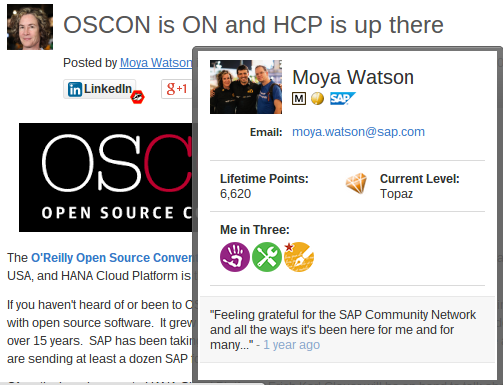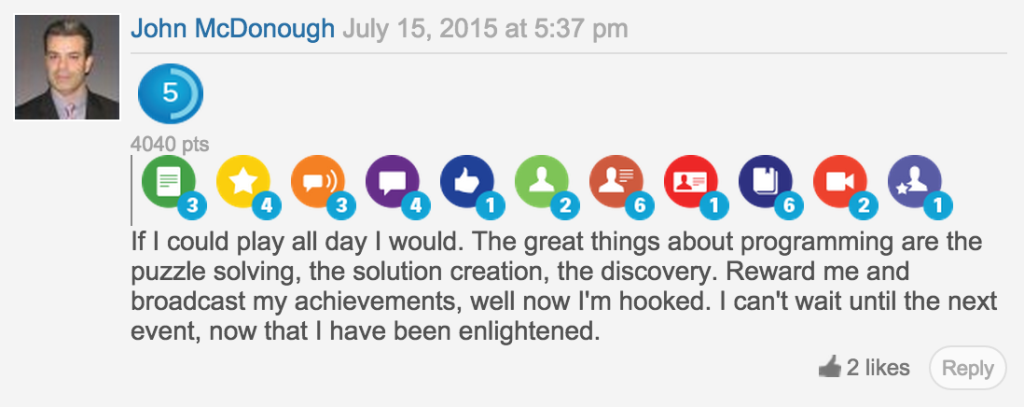In a tweet last week, my old boss at SAP, Mark Yolton, who is now leading Digital at Cisco, challenged the SAP Mentors and me to analyze Cisco’s gamification efforts.

What they have done looks very promising. Before I get into it, I would like to first share what I learned when I stumbled into gamification years before that term even got popular.
In 2004 I felt like the sorcerer’s apprentice after I added a point system to the nascent SAP Developer Network, which developed over the years into the SAP Community Network, SCN. The core of the point system was that an SCN member who had posted a forum question was able to give points for the best answers. It enabled us to create rankings of the top contributors of every forum.
Forum use exploded so much that the servers couldn’t keep up. We had to switch off the drill down functionality to keep the site halfway performing.
Time for a victory lap, one would think, looking at the exploding engagement numbers of posts, visits and views. And we celebrated. But once the confetti was swept away, there was frustration building in the community about the unintended consequences of the point system.
The alarming thing was that the complaints came from some of the most helpful community members, aka top community influencers: the ones that got satisfaction from solving challenging questions, the problem solvers, who are the yeast that makes our community rise.
They saw the quality of the community contributions go down. Point hunters would try to quickly answer any questions even if they only have a vague idea of the right answer in the hopes of gathering points and getting higher in the ranks.
Managers in some SAP consulting companies would set KPIs for their employees to reach a certain amount of SCN points to raise their company profile on SCN. A tiny percentage got carried away and tried to fully game the system by creating fake accounts, questions, answers and raking in points for these fake answers.
This behavior lead to many posts and happy hockey stick engagement reports. But many of the top community influencers were frustrated. Some openly begged us to switch the point system off because of the noise in the forums that the point hunters were creating. I am looking at you Julius Bussche. Others just quietly didn’t visit the forums as often as they had before.
And there I was, like the sorcerer’s apprentice: what to do with the Gamification demons I have awoken?
Insight: There will always be community members that will try to game your system. It’s part of the game, just keep adapting to deal with it.
Create processes:
- Post simple rules of engagement.
- Spell out what happens when the rules are broken.
- Have levels of punishment and easy ways for the moderators to enforce these.
Oh how I wished we had a “go to jail” aka “you can’t post on SCN for a week” button for our moderators. - Do not be afraid to take people off your site. The moderators on SCN came up with the term: Guestifying for that. [By the way: You know that your community has arrived when they develop their own language. That is why we created the SCN Urban Dictionary for others to understand. Guestifying was one of the first words we added to it.]
- Create a process to report new ways of gaming the system. It is an arms race: They find a way to game your system, you set up new barriers, they find ways to get around these barriers, you close that hole. Yes that takes resources, moderators time, development time to code moderator features to fend off the gaming abuses, community development time, so budget accordingly.
That was about 10 years ago. Since then SAP implemented a second iteration of gamification under the leadership of Laure Cetrin and with input by Mario Herger, who, back then, was still working for SAP but now consults around gamification and wrote the Bible for Enterprise Gamification.
Now you can earn badges for specific campaigns that the community managers set up. They are often time-bound, and it gives the community managers a lot of flexibility to highlight and reward positive community behaviour.
Badges and points sometimes feel like fast food, that give you and your community members a temporary good feeling but are bloating the system. You feel guilty afterwards, as it isn’t as nurturing and energy giving (engaging) as you were hoping it would.
You are wondering, was it worth it? [Comedy break: Jim Gaffigan McDonals skit.]
Badges are displayed in your community profile, for a pretty easy overview of your community activities. I love that on SCN you can select your top 3 badges “Me in Three” that will display when someone is hovering over your profile.
Here an example from Moya Watson’s Oscon Blog post:
It would be marvelous, if they were printed on your conference badge too at live events.
Maybe at last week’s CISCO live conference that was the case. A seamless flow from digital to real world and back is the holy grail for community engagement.
Insight: Make it as easy as possible to connect face to face encounters/activities of your community members with their online presence. OCR codes that lead to the community member’s profile on their event badge for easy follow come to mind.
Check out all the icons after Deanna Belle’s name and picture at Cisco’s gamification announcement blog post. It is clear that Cisco is going all out with badges.
If you look over Cisco’s engagement numbers, they look really impressive:
Registrations & Activity:
- Registered 2,656 new DevNet site members – 350% increase over the weekly average
- Registered 2,103 new Community members (44% are developers) – 100% increase over the weekly average
- Registered 932 new DevNet community members – 482% increase over the weekly average
- 9,816 total activities completed by 1334 community members (average of 7.4 activities completed per user)
And, during a big event, registration numbers are always higher. I would love to see a comparison to last year’s registrations during Cisco Live. Also, what was the average engagement last year to the average this year would help me get a feeling for the organic growth without gamification. These numbers would be useful for a more precise picture on the real impact that gamification had on the CISCO community.
Activity is up, no question. Somehow it feels a bit like the turtle and the hare. The numbers look good (fast), but how does the game play out over time? Will it be retained? Does slow and steady win the race? Is it high quality engagement?
What does the CISCO community say?
John McDonough is very enthusiastic:
While Marco Celon is more reserved:
Clearly shows, that the needs and preferences of your community members are not all created equal. Let’s not forget the different stages of community membership. Light gamification is an excellent tool to nudge your members from being a lurker into getting active, answering a post or doing the first steps. CISCO hits the mark with their extensive use of badges.
Once community engagement grows into a daily habit and you know your fellow community members in and out, then these badges lose their attraction and may even be perceived as clutter.
Take also into account how mature your community is overall and adjust the campaigns accordingly.
It was only mentioned in passing that the top price for the hacking competition was $10K. I am left wondering how that influences activity and collaboration between the different teams.
Key for success is to be in constant engagement with top community influencers, share ideas and prototypes with them early and often. Stay nimble, take their input to heart and adjust approach accordingly.
This is why at SAP we created the community advocacy group SAP Mentors 150 nominated by and representing the 3 million SCN members. Small enough for deep engagement, but also large enough to communicate the agreed changes back to the SCNers.
This is a long post, so here a summary regarding gamification:
| Benefits of Gamification | Challenges of Gamification |
|
|
Gamification is a game you have to keep playing. Know its benefits and limitations, impact on your resources and align it with your community goals. Congratulations to CISCO for having done the first big step into the game.
Engage with your community often and together you bring out the best community possible.



